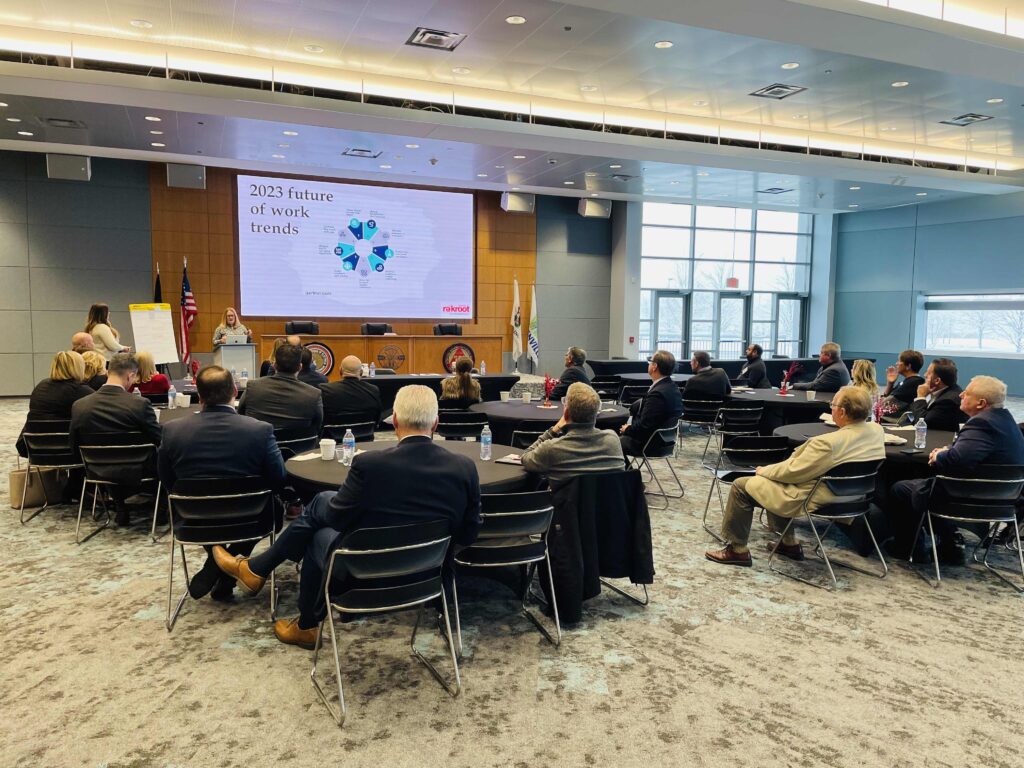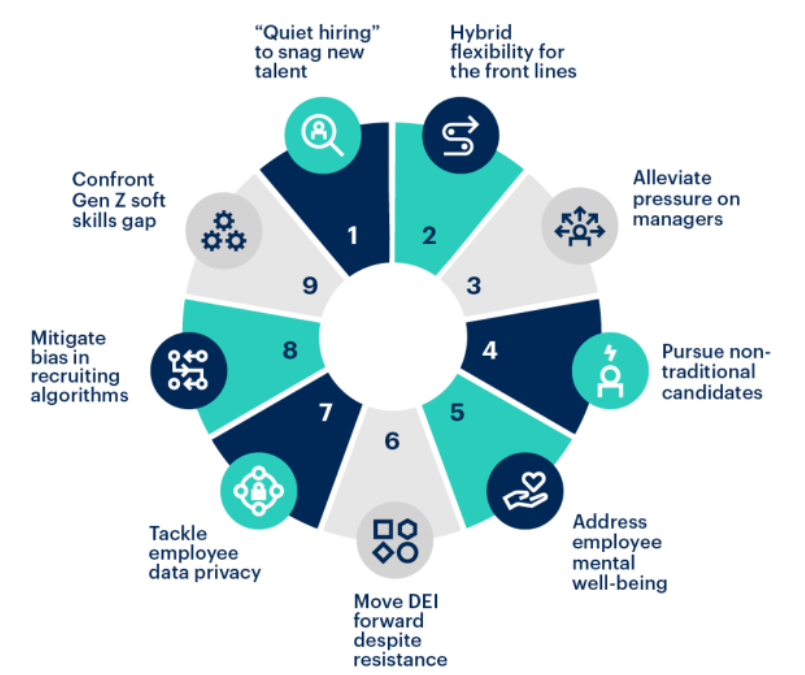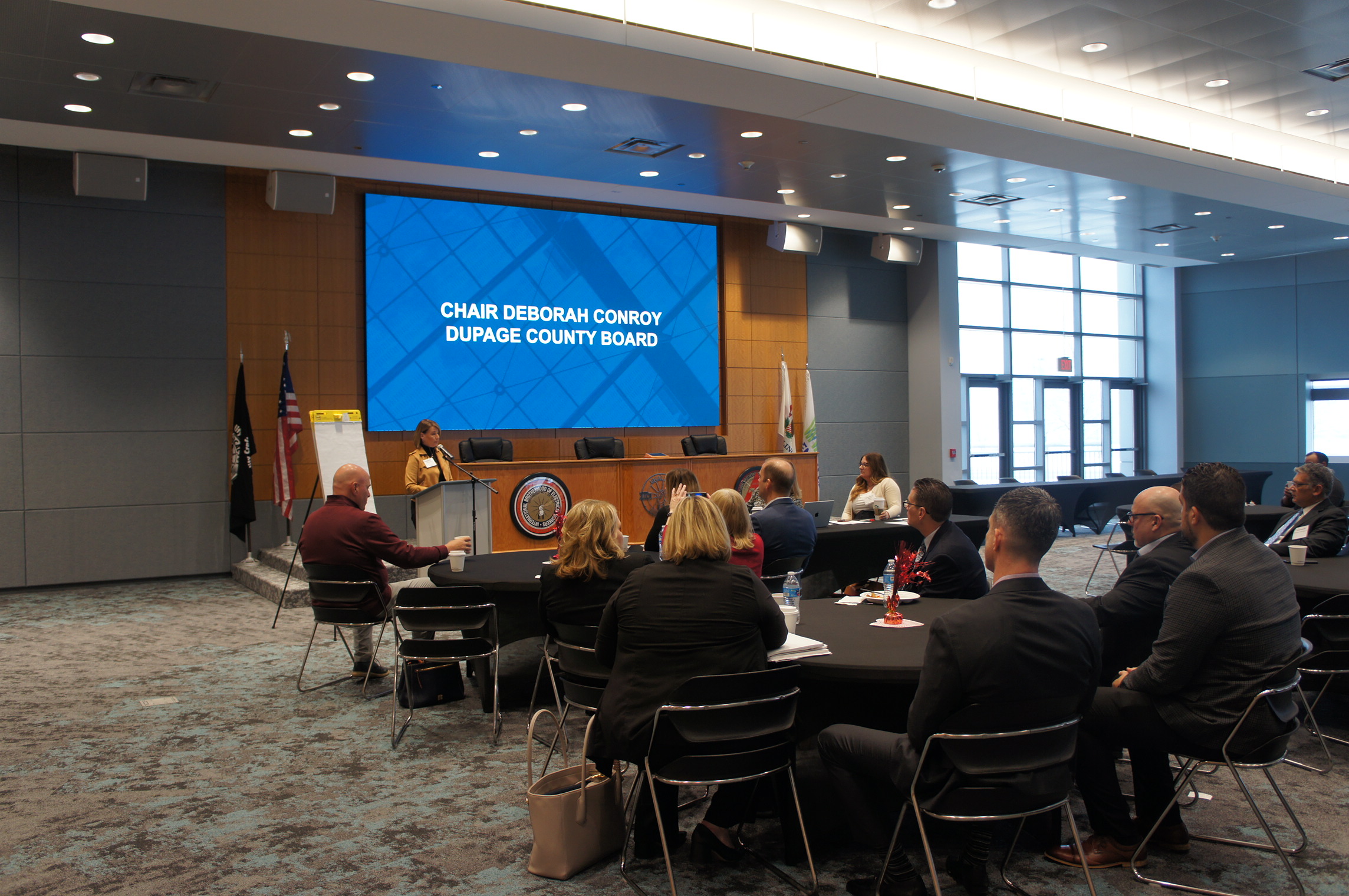DuPage County business leaders gathered at PowerForward DuPage on Wednesday, January 25 for a wide-ranging discussion about talent recruitment and retention. Morgan Freitag Strahan and Kimberly Buck Gough, Co-Founders of Rekroot, a recruiting coaching and consulting company, led the session.
The Hon. Deborah Conroy, Chair of the DuPage County Board, opened the event referencing current labor force challenges. She welcomed the conversation about best practices in “training talent, planting seeds for the labor force we need today… and into the future.” Leaders from banking, manufacturing, government, healthcare, information technology, construction and engineering participated in the lively dialogue. Attendees talked about the difficulty they have finding workers, as well as sharing successes in recruiting and keeping outstanding employees.
2023 Future of Work Trends

Morgan and Kimberly outlined several trends that will be important for managers and employers in the next year.

1). Employers will “quiet hire” in-demand talent.
The concept of “quiet quitting” — the idea of employees refusing to go “above and beyond” and doing the minimum required in their jobs — dominated work-related headlines in the second half of 2022. When employees “quiet quit,” organizations keep people but lose skills and capabilities.
In 2023, savvy organizations will turn this practice on its head and embrace “quiet hiring” as a way to acquire new skills and capabilities without adding new full-time employees. This will manifest as encouraging internal talent mobility, providing upskilling opportunities, and leveraging alternative methods of recruitment.
2). Hybrid flexibility will reach the front lines.
As we enter a more permanent era of hybrid work for desk-based employees, it’s time to find equitable flexibility for frontline workers, like those in manufacturing and healthcare.
Rekroot’s research has found that frontline workers are looking for flexibility when it comes to what they work on, who they work with, and the amount they work — in particular, control over and stability in their work schedule, as well as paid leave.
3). Managers will find themselves sandwiched between leader and employee expectations.
60% of hybrid employees say their manager is their most direct connection to company culture. And yet, managers are struggling to balance their employee expectations of purpose, flexibility, and career opportunities with performance pressure from senior leaders.
In 2023, leading organizations will provide fresh support and training to mitigate the widening managerial skills gap while simultaneously clarifying manager priorities and redesigning their roles where necessary.
4). Pursuit of nontraditional candidates will expand talent pipelines.
For years, organizations have talked about the strategic value of expanding and diversifying their talent pipelines. With more employees charting nonlinear career paths and organizations having trouble meeting their talent needs through traditional sourcing methods, now is the time to act.
To fill critical roles in 2023, organizations will need to become more comfortable assessing candidates solely on the skills needed to perform in the role, rather than their credentials and prior experience. Organizations will do this by removing formal education and experience requirements from job postings and instead reaching out directly to internal or external candidates from nontraditional backgrounds who may not have access to certain professional opportunities, or even be aware of them.
5). Healing pandemic trauma will open path to sustainable performance.
As the immediate COVID-19 threat recedes, our collective adrenaline is wearing off, leaving employees to contend with long-term physical and emotional impacts. Employees’ stress and worry in 2022 grew above even 2020 peaks — nearly 60% of employees report they are stressed at their jobs every day. The societal, economic, and political turbulence of the last few years is manifesting as decreased productivity and performance, no-notice quitting and workplace conflict.
In 2023, leading organizations will support employees by providing:
- Proactive rest to help employees maintain their emotional resilience and performance, as opposed to offering rest as a recovery solution after both have plummeted. This may include proactive PTO before high-demand working periods, no-meeting Fridays, allotted wellness time, and including team PTO in managers’ goals.
- Discussion opportunities to work through challenges and difficult topics without judgment or consequences.
- Trauma counselors to train and coach managers on workplace conflict as well as how to have difficult conversations with employees.
6). Organizations will drive DEI forward amid growing pushbacks.
Rekroot’s research found 42% of employees believe their organization’s DEI efforts are divisive. This pushback to DEI efforts can decrease workforce engagement, inclusion, and trust.
To address this fraught moment and maintain DEI momentum, HR must equip managers with tools and strategies to engage resistant employees and address pushback early before it evolves into more disruptive forms of DEI resistance. This could include:
- Creating group-specific safe spaces based on key employee demographic characteristics (e.g., gender, race/ethnicity) to proactively surface problems.
- Tailoring communications and incentives to motivate allyship, for example, by recognizing and giving visibility to allies on internal platforms and company websites.
- Upskilling employees with definitive “how-to” guidance that enables allyship by showing employees how, specifically, they can advance DEI goals via the actions they take in their professional capacities.
7). Getting personal with employee support will create new data risks.
Being a human organization means knowing more about employees as people — a shift that has the potential to violate boundaries around deeply personal and private information. Organizations are increasingly using emerging technologies — artificial intelligence (AI) assistants, wearables, etc. — to collect data about employees’ health, family situations, living conditions, and mental health. While these technologies can enable employers to respond more effectively to employees’ needs, they also have the potential to create a looming privacy crisis.
In 2023, leading organizations will create an employee data bill of rights to support employees’ need for healthy boundaries in addition to overall well-being. HR leaders should ensure they prioritize transparency around how the organization collects, uses and stores employee data, and allow employees to opt out of practices they find objectionable.
8). Concerns around AI bias will lead to more transparency in recruiting tech.
As more organizations leverage AI in recruiting, the ethical implications of these practices have become more urgent. In 2023, Morgan and Kimberly expect this issue to come to a head, particularly as governments begin scrutinizing the use of AI in hiring.
For example, a new law in New York City went into effect on January 1 that limits employers’ use of AI recruiting tools and requires organizations to undergo annual bias audits and publicly disclose their hiring metrics.
Organizations that use AI and machine learning in their hiring processes, as well as the vendors they rely on for these services, will face pressure to get ahead of new regulations. This includes being more transparent about how they are using AI, publicizing their audit data, and giving employees and candidates the choice to opt out from AI-led processes.
9). Organizations must address workforce-wide erosion of social skills.
Many new-to-the-workforce employees are struggling: 51% of Gen Z employees say that their education has not prepared them to enter the workforce. And the pandemic means that these employees have had few in-person opportunities to observe norms and determine what is appropriate or effective within their organizations.
Rekroot’s analysis has made clear that, in fact, it’s not just Gen Z — everyone’s social skills have eroded since 2020. Burnout, exhaustion, and career insecurity erode performance. No one, from any generation, has cracked the code for navigating our new shared professional environment. Focusing exclusively on Gen Z will not adequately address this challenge; organizations must redefine professionalism for their entire workforce.
Rather than forcing employees back to in-person work to establish connections, leaders need to build intentional connections among employees across geographic — and generational — boundaries. Gartner research shows that to successfully create intentional interactions among employees, employers should focus on three elements: employee choice and autonomy, a clear structure and purpose, and a sense of levity and fun.
Proactive vs. Reactive Recruitment
Morgan and Kimberly explained that proactive recruitment is all about anticipation. It involves anticipating the staffing needs of a business and seeking out candidates before staffing levels become problematic.
Reactive recruitment is all about the here and now, meaning that a company ”reacts” to the loss of an employee by launching a job hunt once a position has been vacated. Reactive recruitment fills an immediate need for employees, rather than anticipating needs going forward.
Reactive recruitment often results in existing employees picking up the slack and covering these shifts until the manager can quickly find a new worker. This can take weeks or sometimes months of reading applications, conducting interviews and training to get a new employee up to speed.
Many companies have moved away from this type of strategy because it puts a lot of pressure on a company to find a worker – sometimes not even an ideal candidate – as quickly as possible. The company, in effect, has gone into panic mode.
Consideration: Look at your employees and figure out how they got into their current job role. Was it a referral? LinkedIn? Glassdoor? That is the recruiting source you should be investing in.
Do you have a recruiting checklist?
Going through a checklist prior to making a hire is a critical component of recruiting. Your checklist should include:
- Creating a complete organizational chart with roles, responsibilities, and more.
- A clear understanding of the responsibilities and expectations of the open position.
- Researching the average salary for the open position.
- Company expectations for work environment – hybrid, virtual, etc.
- A defined selection process.
- And more.
Click here to view Rekroot’s checklist.
Choose DuPage provides industry-sector reports that include relevant workforce information including average salaries. To request a report, click here.
“The executives who ignited the transformations from good to great did not first figure out where to drive the bus and then get people to take it there. No, they first got the right people on the bus (and the wrong people off the bus) and then figured out where to drive it.”
Jim Collins (Good to Great)
About Rekroot
Rekroot is your recruiting partner, offering extensive consulting and coaching or providing you with a steady stream of qualified candidates so that you make the best and strongest hiring selections for your growing financial services business.


